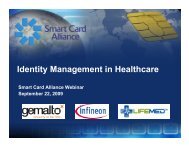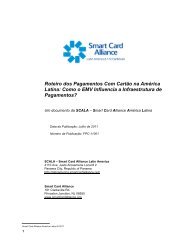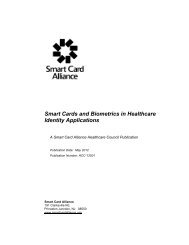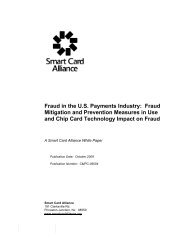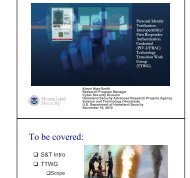PIV-I White Paper - FINAL - 022111 - Smart Card Alliance
PIV-I White Paper - FINAL - 022111 - Smart Card Alliance
PIV-I White Paper - FINAL - 022111 - Smart Card Alliance
You also want an ePaper? Increase the reach of your titles
YUMPU automatically turns print PDFs into web optimized ePapers that Google loves.
3.2.6 Other Ongoing EffortsDHS and the Federal Emergency Management Agency (FEMA) have been working with many states ondeploying First Responder Authentication Credentials (FRAC), leveraging the <strong>PIV</strong>-I framework. Amongthe states, Virginia, Texas, Pennsylvania, Colorado, West Virginia, Hawaii and the District of Columbiahave reported significant benefits as a result of their activities. 25In late 2009, the Command, Control and Interoperability (CCI) Division within the Science & Technology(S&T) Directorate, the FEMA Office of National Capital Region Coordination (NCRC), and the FEMAOffice of Security (OS) partnered to convene the <strong>PIV</strong>-I/FRAC Technology Transition Working Group(TTWG). The TTWG is composed of state and local emergency management representatives, many ofwhom have already implemented innovative and secure identity management solutions in their ownjurisdictions. Local and state participants in the work group include Colorado, Maryland, Virginia, Districtof Columbia, Missouri, Southwest Texas, Pennsylvania, West Virginia, Hawaii, and Illinois. The workinggroup is focused on exploring <strong>PIV</strong>-I credentials as the standard that will enable interoperability betweenlocal and state emergency response officials. 263.3 SummaryThe adoption of interoperable credential technology and infrastructure by such industry groups as theaerospace and defense and the biopharmaceutical industries and by Federal and state agencies isexpanding the deployed based of interoperable products. Broader <strong>PIV</strong>-I adoption will move theinfrastructure toward a tipping point where the standards-based solution has significant benefits over nonstandards-basedapproaches. Most businesses, states, counties, and cities are still supporting hundredsof legacy identity solutions that were developed to support limited-use applications or networked users.Continuing to support such identity and authentication solutions incurs operational costs and adds little orno value for the taxpayers served by these systems.With the time required for implementation decreasing and number of readily available products andservices increasing, state, county, and city officials as well as business leaders can easily leverage theFederal Government’s work on <strong>PIV</strong>. Following the path blazed by the Federal Government and earlyadopters by implementing a standards-based <strong>PIV</strong> credential can result in successful credentialing andidentity management solutions that reduce the challenges of managing identities and attributes.25 "Moving towards Credentialing Interoperability: Case Studies at the State, Local and Regional Level," U.S.Department of Homeland Security, July 2010 2526 <strong>PIV</strong>-I/FRAC Technology Transition Working Group, U.S. Department of Homeland Security Command, Control andInteroperability Division<strong>Smart</strong> <strong>Card</strong> <strong>Alliance</strong> © 201114









